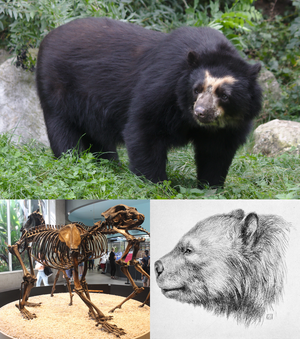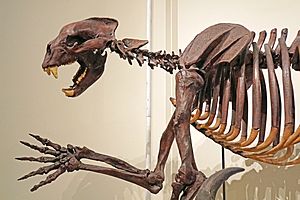Short-faced bear facts for kids
Quick facts for kids Short-faced bear |
|
|---|---|
 |
|
| Spectacled bear, Arctodus simus and Arctotherium bonariense | |
| Scientific classification |
|
| Kingdom: | Animalia |
| Phylum: | Chordata |
| Class: | Mammalia |
| Order: | Carnivora |
| Family: | Ursidae |
| Subfamily: | Tremarctinae Merriam & Stock, 1925 |
| Genera | |
|
†Arctodus |
|
The Tremarctinae, also known as short-faced bears, are a group of bears. Today, only one type of short-faced bear is still alive: the spectacled bear (Tremarctos ornatus). This bear lives in South America.
Many other short-faced bears are now extinct. These include giant bears like Arctodus simus from North America and Arctotherium angustidens from South America. These giant short-faced bears might have been the biggest meat-eating mammals ever in the Americas!
Scientists believe this group of bears first appeared in eastern North America. Later, they moved into South America. Most of these amazing short-faced bears disappeared at the end of the Pleistocene Ice Age.
Contents
Discovering Short-Faced Bears
Scientists John Merriam and Chester Stock first named the Tremarctinae group in 1925. They studied how these bears are related to each other.
Early studies suggested that Plionarctos and Tremarctos were older types of short-faced bears. They thought these were ancestors to Arctodus and Arctotherium. However, newer research shows that Arctotherium bears are actually closer relatives to the spectacled bear than to Arctodus. This means that the giant size seen in both Arctodus and Arctotherium might have developed separately. This is called convergent evolution, where different species develop similar traits.
What Makes Them Special?
Skull Features
Short-faced bears get their name because their snouts look shorter than other modern bears. But this is a bit of an illusion! Their skulls were actually taller and deeper, making their nasal bones seem shorter.
Their skulls also had strong zygomatic arches (cheekbones). These strong bones helped them chew powerfully. They also had larger, rounder eyes that faced more to the sides. This is different from most other bears.
One unique feature was a special groove on their lower jaw. This groove helps scientists tell adult short-faced bears apart from younger ones. Their teeth, especially a specific molar, could also vary a lot between individuals.
Body and Footprints
Scientists can even learn about these bears from their footprints! A type of fossil footprint called Ursichnus sudamericanus is linked to Arctotherium tarijense. Unlike other bear footprints, the heel mark is missing in the front paw. Also, the middle toe print is longer than the others.
These footprints suggest that all short-faced bears had long claws. Their five toes were arranged in a gentle curve. All these bears walked flat-footed, like humans. Some short-faced bears had shorter feet (like the spectacled bear), while others had longer feet (like Arctodus).
How Short-Faced Bears Evolved
The story of short-faced bears began with their ancestor, Plionarctos. This bear lived in North America about 7 million years ago. Plionarctos fossils are found until about 3 million years ago.
Around 5.3 million years ago, many types of bears, including short-faced bears, rapidly became more diverse. This happened when the world's climate changed. Temperatures dropped, and open grasslands became common. Many animal groups in Eurasia and North America disappeared during this time.
Genetic studies show that Arctotherium, Arctodus, and Tremarctos started to become distinct species between 5.5 and 4.8 million years ago. Arctotherium and Tremarctos separated about 4.1 million years ago. All three groups first appeared in North America.
Spreading Across the Americas
Later, short-faced bears began to spread throughout North and South America. In the Early Pleistocene, a medium-sized bear called Arctodus pristinus lived across North America. The Florida spectacled bear lived only along the Gulf Coast.
The first Arctotherium bears in South America were huge! Arctotherium angustidens appeared in Argentina around 1 million years ago. It might have been the largest meat-eating land mammal ever. How Arctotherium evolved before this in South America is still a mystery.
During the Middle Pleistocene, new forms of these bears appeared. Arctodus pristinus was replaced by the enormous Arctodus simus. This giant bear lived all over North America, from Alaska to Mexico. Arctotherium angustidens was replaced by several smaller species in South America. These included Arctotherium vetustum, Arctotherium bonariense, and Arctotherium tarijense.
Arctotherium wingei was a smaller species. It was unique because it was the only Arctotherium to live mainly north of the Southern Cone and even moved back into Central America.
The End of an Era
By the end of the Pleistocene Ice Age, about 11,700 years ago, many short-faced bears were still around. Arctodus simus, Tremarctos floridanus, Arctotherium tarijense, and Arctotherium wingei lived from Alaska all the way to southernmost Patagonia. However, all these species became extinct by the early Holocene epoch.
Around this time, the spectacled bear (Tremarctos ornatus) started to appear in the fossil record of South America. Scientists think the spectacled bear moved into Central and South America after Arctotherium wingei disappeared.
How Short-Faced Bears Lived
Short-faced bears lived in many different ways. Some were smaller and ate mostly plants, living in forests. Examples include Arctotherium wingei and the living spectacled bear.
Others were huge, like Arctotherium angustidens and Arctodus simus. These giants lived in open plains. They were omnivores, meaning they ate both plants and meat, but they loved to eat a lot of meat!
Giant Bear Differences
Even though the two giant species looked similar, they had important differences. Arctodus simus lived across North America for 800,000 years. But Arctotherium angustidens seemed to live only in the Southern Cone of South America.
Their diets also differed. Arctodus simus' diet changed depending on where it lived. In Alaska, it ate a lot of meat. In other places, it ate a mix of plants and meat. Arctotherium angustidens, however, always ate a lot of meat, no matter where it was found.
Scientists also noticed that Arctodus was more slender, while Arctotherium angustidens was very strong and robust. This difference has puzzled researchers. One idea is that when other large meat-eating scavengers died out in the Pliocene, it created an opportunity. This might have encouraged Arctodus and Arctotherium to grow to such giant sizes.
Eating Habits
Arctodus and Tremarctos bears have features common in plant-eating animals. They had large, flat cheek teeth for grinding food. Their lower jaws were deep, with strong muscles for chewing.
Since meat-eating animals don't digest plants easily, they need to chew them a lot. These jaw features helped them chew plants very well. This suggests that eating plants might have been a common trait for early short-faced bears. It also shows what some of them preferred to eat.
Family Tree of Short-Faced Bears
This cladogram shows how different groups of bears are related, with a focus on the Tremarctinae.
| Tremarctinae within Ursidae | |||||||||||||||||||||||||||||||||||||||||||||||||||
|
Here is a list of the different types of short-faced bears, based on studies by Mitchell et al. (2016):
- Subfamily Tremarctinae Merriam & Stock, 1925
- †Plionarctos Frick, 1926
- †Plionarctos edensis Frick, 1926
- †Plionarctos harroldorum Tedford & Martin, 2001
- †Arctodus Leidy, 1854
- †Arctodus pristinus Leidy, 1854
- †Arctodus simus Cope, 1879
- †Arctotherium Burmeister, 1879
- †Arctotherium angustidens Gervais & Ameghino, 1880
- †Arctotherium bonariense Gervais, 1852
- †Arctotherium tarijense Ameghino, 1902
- †Arctotherium vetustum Ameghino, 1885
- †Arctotherium wingei Ameghino, 1902
- Tremarctos Gervais, 1855
- †Tremarctos floridanus (Gildey, 1928)
- Tremarctos ornatus (Cuvier, 1825) – spectacled bear
- †Plionarctos Frick, 1926
See also
 In Spanish: Tremarctinos para niños
In Spanish: Tremarctinos para niños
- Pleistocene megafauna
- Pleistocene extinctions


